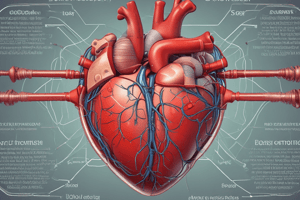Podcast
Questions and Answers
During which phase of the cardiac cycle does the atrial pressure slightly increase due to the entry of blood from the atria?
During which phase of the cardiac cycle does the atrial pressure slightly increase due to the entry of blood from the atria?
- Atrial systole
- Ventricular diastole (correct)
- Proto-diastolic phase
- Ventricular systole
What happens to the aortic pressure during the Isometric (iso-volumetric) contraction phase of the cardiac cycle?
What happens to the aortic pressure during the Isometric (iso-volumetric) contraction phase of the cardiac cycle?
- Increases markedly as a result of ventricular contraction (correct)
- Decreases slightly due to reduced force of pumping blood into the aorta
- Increases slightly due to entry of blood from the atria
- Remains constant
What is the duration of the Maximum ejection phase in Ventricular systole?
What is the duration of the Maximum ejection phase in Ventricular systole?
- 0.1 seconds
- 0.15 seconds (correct)
- 0.05 seconds
- 0.3 seconds
Which phase follows Atrial systole in the cardiac cycle and continues for 0.3 seconds?
Which phase follows Atrial systole in the cardiac cycle and continues for 0.3 seconds?
What happens to A-V valves during the Atrial systole?
What happens to A-V valves during the Atrial systole?
What happens when the ventricle pressure exceeds atrial pressure?
What happens when the ventricle pressure exceeds atrial pressure?
Why does the aortic pressure show a sharp decrease followed by a gradual increase?
Why does the aortic pressure show a sharp decrease followed by a gradual increase?
What is the primary reason for the slight decrease in ventricular volume when all valves are closed?
What is the primary reason for the slight decrease in ventricular volume when all valves are closed?
During ventricular systole, what happens to the A-V ring?
During ventricular systole, what happens to the A-V ring?
Why do all cardiac valves become closed when ventricular pressure exceeds atrial pressure?
Why do all cardiac valves become closed when ventricular pressure exceeds atrial pressure?
Flashcards are hidden until you start studying
Study Notes
Cardiac Cycle
- The cardiac cycle is the sequence of events in the heart from the beginning of one heartbeat to the beginning of the next, lasting around 0.8 seconds with a heart rate of 75 beats per minute.
Phases of the Cardiac Cycle
- The cardiac cycle consists of four phases: atrial systole, ventricular systole, proto-diastolic phase, and ventricular diastole.
Atrial Systole
- Atrial systole is the first phase of the cardiac cycle, lasting around 0.1 seconds.
- During this phase, the atria contract, pushing 30% of their blood into the ventricles, causing:
- Atrial pressure to temporarily increase from zero to 2 mmHg due to atrial contraction, then return to zero as the atria evacuate.
- Ventricular pressure to increase due to the entry of blood from the atria.
Ventricular Systole
- Ventricular systole is the second phase of the cardiac cycle, lasting around 0.3 seconds, and consists of three sub-phases:
- Isometric contraction phase (0.05 seconds): ventricular pressure increases rapidly from zero to 80 mmHg in the left ventricle and from zero to 10 mmHg in the right ventricle.
- Maximum ejection phase (0.15 seconds): ventricular pressure exceeds atrial pressure, causing the sudden closure of A-V valves, making the heart a closed chamber.
- Reduced ejection phase: ventricular pressure continues to increase, but at a slower rate.
Ventricular Diastole
- Ventricular diastole is the fourth phase of the cardiac cycle, characterized by:
- Ventricular pressure decreasing as the ventricles relax.
- Atrial pressure increasing slightly due to the entry of blood from the atria.
- Ventricular volume decreasing as the ventricles pump blood into the aorta.
Valve Activity
- During the cardiac cycle, valves are dynamically opening and closing:
- A-V valves: open during ventricular diastole and close during ventricular systole.
- Semilunar valves: closed during ventricular diastole and open during ventricular systole.
Studying That Suits You
Use AI to generate personalized quizzes and flashcards to suit your learning preferences.




